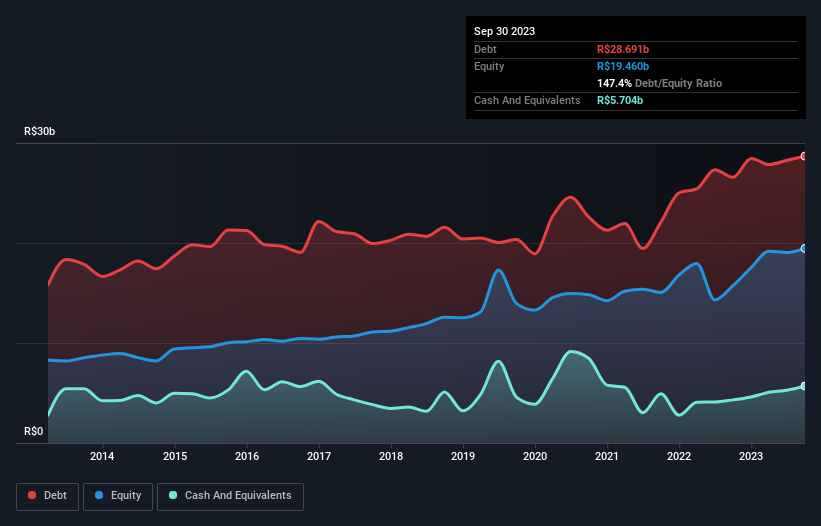
Legendary fund manager Li Lu (who Charlie Munger backed) once said, 'The biggest investment risk is not the volatility of prices, but whether you will suffer a permanent loss of capital.' So it seems the smart money knows that debt - which is usually involved in bankruptcies - is a very important factor, when you assess how risky a company is. Importantly, CPFL Energia S.A. (BVMF:CPFE3) does carry debt. But should shareholders be worried about its use of debt?
When Is Debt Dangerous?
Generally speaking, debt only becomes a real problem when a company can't easily pay it off, either by raising capital or with its own cash flow. Ultimately, if the company can't fulfill its legal obligations to repay debt, shareholders could walk away with nothing. However, a more frequent (but still costly) occurrence is where a company must issue shares at bargain-basement prices, permanently diluting shareholders, just to shore up its balance sheet. Of course, plenty of companies use debt to fund growth, without any negative consequences. When we think about a company's use of debt, we first look at cash and debt together.
View our latest analysis for CPFL Energia
What Is CPFL Energia's Net Debt?
You can click the graphic below for the historical numbers, but it shows that as of September 2023 CPFL Energia had R$28.7b of debt, an increase on R$26.6b, over one year. However, because it has a cash reserve of R$5.70b, its net debt is less, at about R$23.0b.

How Strong Is CPFL Energia's Balance Sheet?
We can see from the most recent balance sheet that CPFL Energia had liabilities of R$20.0b falling due within a year, and liabilities of R$34.3b due beyond that. Offsetting this, it had R$5.70b in cash and R$8.41b in receivables that were due within 12 months. So it has liabilities totalling R$40.2b more than its cash and near-term receivables, combined.
This deficit is considerable relative to its market capitalization of R$42.0b, so it does suggest shareholders should keep an eye on CPFL Energia's use of debt. This suggests shareholders would be heavily diluted if the company needed to shore up its balance sheet in a hurry.
We measure a company's debt load relative to its earnings power by looking at its net debt divided by its earnings before interest, tax, depreciation, and amortization (EBITDA) and by calculating how easily its earnings before interest and tax (EBIT) cover its interest expense (interest cover). This way, we consider both the absolute quantum of the debt, as well as the interest rates paid on it.
CPFL Energia's net debt to EBITDA ratio of about 1.7 suggests only moderate use of debt. And its strong interest cover of 13.5 times, makes us even more comfortable. Also relevant is that CPFL Energia has grown its EBIT by a very respectable 28% in the last year, thus enhancing its ability to pay down debt. There's no doubt that we learn most about debt from the balance sheet. But it is future earnings, more than anything, that will determine CPFL Energia's ability to maintain a healthy balance sheet going forward. So if you're focused on the future you can check out this free report showing analyst profit forecasts.
But our final consideration is also important, because a company cannot pay debt with paper profits; it needs cold hard cash. So the logical step is to look at the proportion of that EBIT that is matched by actual free cash flow. Looking at the most recent three years, CPFL Energia recorded free cash flow of 32% of its EBIT, which is weaker than we'd expect. That weak cash conversion makes it more difficult to handle indebtedness.
Our View
CPFL Energia's interest cover was a real positive on this analysis, as was its EBIT growth rate. On the other hand, its level of total liabilities makes us a little less comfortable about its debt. It's also worth noting that CPFL Energia is in the Electric Utilities industry, which is often considered to be quite defensive. When we consider all the elements mentioned above, it seems to us that CPFL Energia is managing its debt quite well. Having said that, the load is sufficiently heavy that we would recommend any shareholders keep a close eye on it. There's no doubt that we learn most about debt from the balance sheet. However, not all investment risk resides within the balance sheet - far from it. Be aware that CPFL Energia is showing 3 warning signs in our investment analysis , and 1 of those shouldn't be ignored...
Of course, if you're the type of investor who prefers buying stocks without the burden of debt, then don't hesitate to discover our exclusive list of net cash growth stocks, today.
New: AI Stock Screener & Alerts
Our new AI Stock Screener scans the market every day to uncover opportunities.
• Dividend Powerhouses (3%+ Yield)
• Undervalued Small Caps with Insider Buying
• High growth Tech and AI Companies
Or build your own from over 50 metrics.
Have feedback on this article? Concerned about the content? Get in touch with us directly. Alternatively, email editorial-team (at) simplywallst.com.
This article by Simply Wall St is general in nature. We provide commentary based on historical data and analyst forecasts only using an unbiased methodology and our articles are not intended to be financial advice. It does not constitute a recommendation to buy or sell any stock, and does not take account of your objectives, or your financial situation. We aim to bring you long-term focused analysis driven by fundamental data. Note that our analysis may not factor in the latest price-sensitive company announcements or qualitative material. Simply Wall St has no position in any stocks mentioned.
About BOVESPA:CPFE3
CPFL Energia
Engages in the generation, transmission, distribution, and commercialization of electricity to residential, industrial, and commercial customers in Brazil.
Very undervalued with adequate balance sheet.

